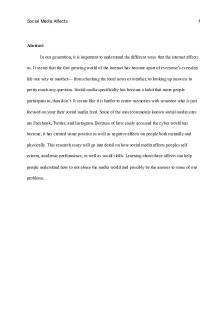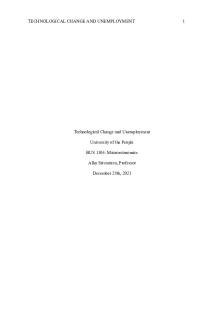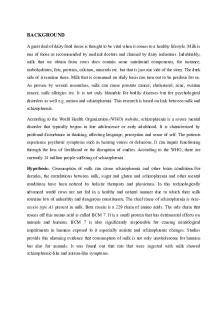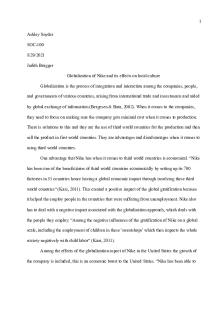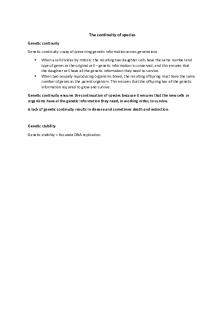Social Media and its Effects on Mental Health PDF

| Title | Social Media and its Effects on Mental Health |
|---|---|
| Author | European Scientific Journal ESJ |
| Pages | 7 |
| File Size | 151.9 KB |
| File Type | |
| Total Downloads | 94 |
| Total Views | 176 |
Summary
European Scientific Journal March 2020 edition Vol.16, No.8 ISSN: 1857 – 7881 (Print) e - ISSN 1857- 7431 Social Media and its Effects on Mental Health Sonu Vatsa, Mrigakshika Sharma, Lali Koptonashvili, European University, Tbilisi, Georgia Doi:10.19044/esj.2020.v16n8p1 URL:http://dx.doi.org/10.190...
Description
European Scientific Journal March 2020 edition Vol.16, No.8 ISSN: 1857 – 7881 (Print) e - ISSN 1857- 7431
Social Media and its Effects on Mental Health
Sonu Vatsa, Mrigakshika Sharma, Lali Koptonashvili, European University, Tbilisi, Georgia Doi:10.19044/esj.2020.v16n8p1
URL:http://dx.doi.org/10.19044/esj.2020.v16n8p1
Abstract There is no doubt that various social media platforms have transformed the new generation. The social media has resulted in the transformation of not only how this generation communicates, but has also transformed business, education and above all, the entertainment. Not only that the social media has made a lot of positive impacts on the human life, it has a lot of negative impacts on all age group as well, especially the youth. Addiction of social media is in trend and is a major contributing factor to rapid increase in several mental health issues. Some of the examples of the issues arising from the excessive use of social media that are on rise include: disturbed circadian rhythm, sleep disorders, reproductive health, phantom vibration, and ringing syndrome. Therefore, this study surveyed the extent to which the mental health is being hampered by excessive use of social media. This study was conducted in two stages surveying 263 participants from India, Russia, Nepal, Ukraine, Kazakhstan, and Georgia. A questionnaire was used as a research instrument, which was sent to the random respondents to study their indulgence in social media. Findings from these responses showed that the mental health issues are associated to the social media usage. Therefore, stakeholders must take remedial action to prevent rampancy of social media usage. From the study conducted, the effects of the social media are not only taking toll on the social life, life style, and physical heath of the users but, also over their mental health. There are urgent needs to take immediate remedial measures to counter this growing menace in the society. Keywords: Addiction, Mental Health, Circadian Rhythm, Sleep Disorders, Phantom Vibration Syndrome, Phantom Ringing Syndrome Introduction Social media (SM) is a web-based anastomosis of various individuals with different or similar interests. It is the quickest and most advance method
1
European Scientific Journal March 2020 edition Vol.16, No.8 ISSN: 1857 – 7881 (Print) e - ISSN 1857- 7431
of connecting to families, relatives, friends, and colleagues. There are approximately 2.77 billion users on different social sites throughout the globe with estimation of approximately 3.02 billion users by the end of the year 2021, with the 18 – 35 years age group being the dominating one. On social sites, showing the suggestions of mutual friends is one of the best and preferred principles of connecting users. As a result, these SM companies are spending billions of dollars per year to make their sites more updated, attractive, interactive, and entertaining. There is cut throat competition among various SM platforms. They find more and more creative ways so that users can spend more time on their site because the more time spent by users on the site, the more is the profit to the companies. One of the methods used by these companies to generate revenue is advertisement suggestions for the similar interest-based products depending on the web search of the user. Often, users spend most of their time chatting, streaming videos, posting pictures, sharing meme among others. These activities create a pleasure in users, which they constantly crave for, leading to addiction. Many studies have shown the addiction level among users. There is a mental outcome of this addiction that leads to severe complications in normal physiological functions of brain and body. Therefore, this article pays its attention towards the mental issues arising from the excessive use of SM. Addiction and its cause Addiction to SM is a frequent urge of accessing it where in the users are unable to resist themselves from using it. “SM addiction can be viewed as one form of internet addiction, where individuals exhibit a compulsion to use SM to excess” (Griffiths, 2000 and Starcevic, 2013). Addiction is a disorder by choice in which the level of dopamine spikes above the normal threshold level, rewarding the brain. Chronic usage of SM sets the level of dopamine higher than required threshold level, as a result, creating an urge to use SM frequently. Such users have difficulty in concentrating in their work and lack attention. Circadian Rhythm Light stimuli that enter from the eyes go to suprachiasmatic nucleus (SCN), also known as biological clock of body present in supra optic region of hypothalamus from where it goes to pineal gland. Hypothalamus is the regulatory center of the body that is mainly involved in circadian rhythm (CR), memory, endocrine system, mood, and emotions. CR maintains 24-hour day and night cycle of body. It maintains sleepiness and wakefulness, menstrual cycle, body homeostasis, hormone release, eating habits, and even helps in differentiating between seasons. CR is maintained by melatonin, a hormone released by pineal gland located on posterior side of thalamus. Melatonin is 2
European Scientific Journal March 2020 edition Vol.16, No.8 ISSN: 1857 – 7881 (Print) e - ISSN 1857- 7431
secreted actively during night (dark) and to some extent during day due to exposure of light from eyes via SCN (Fox, S. I. (2011). Human Physiology, 12th Edition. New York, USA: Mc Graw Hill). Light is the inhibiting factor for melatonin secretion. Disturbance in CR can lead to sleep disorders, memory loss, irregular menstrual cycle, and behavior change. Many studies have shown that nurses and air attendants working in night shift often complain of irregular menstrual cycle. Due to disturbed life style there is an imbalance in the ovarian hormones, which can influence breast cancer (David, J. K, Daniel G. H, Cornelis J. H. van de V, and Michael, B. (2016). Oxford Textbook of Oncology, 3rd Edition. London, UK: Oxford University Press). Excessive use of SM, especially at late nights, leads to inadequately breaking the day and night cycle of the body. As a result, disturbing the biological clock. SM addicts surfing web till late in the night are in constant exposure of light to SCN, which inhibits the release of melatonin and causes an imbalance in their biological clock.
Levels of Melatonin during day and night.
Sleep and its Association with Memory There are two types of sleep patterns, Non-Rapid Eye movement (NREM) and Rapid Eye Movement (REM). NREM consists of four stages followed by REM. The first stage of NREM is a light sleep where moderate stimuli can cause arousal. The second stage is true sleep where sensitivity to arousal further decreases. In the third stage, sleep deepens and lastly, in the fourth stage, arousal is difficult. These stages are followed by REM stage of deepest sleep associated with dreaming where body need higher stimulus to wake (Davis, L. E, Richardson, S. P. (2015). Fundamentals of Neurologic Disease, 2nd Edition. New York, USA: Springer Science+Busisness Media). REM sleep is 20 – 25% of the entire sleep duration and is of approximately 90 – 120 minutes duration (Davis, L. E, Richardson, S. P. (2015). Fundamentals of Neurologic Disease, 2nd Edition. New York, USA: Springer 3
European Scientific Journal March 2020 edition Vol.16, No.8 ISSN: 1857 – 7881 (Print) e - ISSN 1857- 7431
Science+Busisness Media). REM is more prominent towards the morning hours. The optimum sleeping hours for children is 8 – 10 hours and for adults, it is 6 – 7 hours. REM is essential for consolidating short term memory into long term memory (Gazzaniga, M. S. (2013). Cognitive Neuroscience, 4th Edition. New York, USA: W. W. Norton &). Memory consists of registration, retention or consolidation, recollection and is saved in the form of neurotransmitters (Verulashvili, I. (2016). Nervous Diseases Propaedeutics And Topical Diagnosis. Tbilisi, Georgia). SM addicts sleeping late in the night, might face trouble with consolidating memory due to inability to achieve REM sleep because this is the time when neurons are likely to be ‘replaying’ the learnt task, converting short term memory to long term memory (Gazzaniga, M. S. (2013). Cognitive Neuroscience, 4th Edition. New York, USA: W. W. Norton &). Phantom Vibration and Phantom Ringing Syndrome Phantom vibration syndrome and phantom ringing syndrome (Goyal, A. K. (2015). Studies on phantom vibration and ringing syndrome among postgraduate students. Indian Journal of Community Health, 27(1), 35-40.) are the emerging disorders in the youth. These are the condition in which users perceive virtual sensation of vibrations and sound when there is actually no such episode. These include a false feeling of notification popping, receiving text, and calls. There is no such evident proof for the mechanism of these syndromes. This might be occurring due to excessive stimulation of “central pattern generators,” which produce action without any external stimuli. Nomophobia, which is the fear of not having mobile phone is generally accompanied with anxiety and is associated with these syndromes. Methodologies The study was conducted on 263 participants of the 19 – 25 age group and involved two stages. First stage was an online survey conducted over 100 participants from various universities in India, Nepal, Russia, Kazakhstan and Ukraine. The purpose was to eliminate common regional lifestyle. Second stage was an offline survey conducted randomly on 163 participants from European University, New Vision University, and Tbilisi State Medical University, Tbilisi, Georgia. The participants were given questionnaire comprising 12 questions covering several aspects related to their daily SM usage. Research Instrument: 1. Do you have any SM account like Facebook? If yes, specify your age when you started using it. 2. Do you check your SM account just after waking up? 3. Do you check your SM account before you sleep in the night? 4
European Scientific Journal March 2020 edition Vol.16, No.8 ISSN: 1857 – 7881 (Print) e - ISSN 1857- 7431
4. How many times a day do you check your SM account? 5. Do you feel like using your SM account such as Facebook and Instagram in between your work or study? 6. Do you feel anxious without using your SM account just for 2 – 3 days? 7. Do you often sleep late in the night because of SM usage such as accessing YouTube, Facebook or Instagram? 8. How far do you keep your phone when you sleep in the night? 9. Do you think your behavior for others has changed after using SM? 10. What do you feel for your memory power after using SM for years? 11. Do you have a constant desire of getting more likes and comments on your SM posts, and increasing your followers? 12. Do you sometimes feel virtual sensation or sound of your phone (like notifications popping, receiving text or calls)? Observations Q.No 1 2
3
4
5 6 7 8
9 10
11 12
5
Options First Stage (%) Second Stage (%) Average Percentage Yes 93.94 97.00 95.47 No 06.06 03.00 04.53 Always 43.00 32.07 37.53 Sometimes 31.00 45.89 38.49 Never 26.00 16.11 21.05 Always 50.41 39.37 44.98 Sometimes 20.00 39.98 29.99 Never 29.59 14.73 44.32 10-20 times 52.06 52.06 1-10 times 39.13 39.13 _ Others 08.81 08.81 Yes 39.39 48.22 43.80 No 57.58 41.10 49.34 Yes 39.18 46.19 42.68 No 59.79 53.45 56.62 Yes 67.65 67.65 _ No 23.26 23.26 Close to pillow 43.07 43.07 Table besides bed 34.11 34.11 _ Quiet distant 15.02 15.02 Yes 29.59 59.68 44.63 No 57.14 41.31 49.22 Decreased 26.53 26.46 26.49 Increased 26.53 26.49 26.49 No effect 46.94 38.75 42.84 Yes 35.04 35.04 _ No 56.65 56.65 Yes 55.95 55.95 _ No 31.49 31.49 * There were few participants who didn’t attempt few questions. ** Few questions were added only after conducting first stage.
European Scientific Journal March 2020 edition Vol.16, No.8 ISSN: 1857 – 7881 (Print) e - ISSN 1857- 7431
After computing and analyzing the data from both stages it was found that 95.47% of the participants used various SM platforms. Approximately 52.06% participants used their SM accounts 10 – 20 times a day. Almost 44% participants feel urge, anxiety without using SM accounts, 55.95% participants feel phantom vibrations and phantom sounds, 67.65% participants sleep late in the night with reported time being between 2 – 4 a.m, 26.49% participants reported decrease in their memory power, 43.07% keep their mobile phones under their pillow, which is again cause of concern because studies have shown the ill effect of radiations on brain and spermatogenesis (Tas, M., Dasdag, S., Akdag, M. Z., Cirit, U., Yegin, K., Seker, U., ... & Eren, L. B. (2014). Long-term effects of 900 MHz radiofrequency radiation emitted from mobile phone on testicular tissue and epididymal semen quality. Electromagnetic biology and medicine, 33 (3), 216-222. ), 44.63% participants reported a change in behavior. Some mentioned that they have difficulty in concentrating, are irritated most of the time, have increased level of stress, developed a feeling of hatred for others, and loneliness has taken over them. Some also reported that they do not bother if anyone is around them or not. Some even have developed a feeling of hallucination. Conclusion The study indicated that, the SM addiction is on a rapid increase in the new generation. Despite positive impacts of technology and SM, it has made some negative impacts on the life style of the new generation. With the advent of smartphones and latest technologies, the new generation has handcuffed itself to SM. One of the noticeable negative impacts of rapid increase in the SM addiction is the damage to our most valuable processes, such as sleep, consolidation of memory, affecting CR, reproductive health, attention and behavioral changes. It is high time that the society takes cognizance of this menace, and takes corrective action before it is too late. Some precautions, such as switching off Wi-Fi router when not in use, establishing time limit for SM usage, delete time consuming applications, and participating more in outdoor activities, which can be taken up to comprehend these adverse effects. References: 1. (n.d.). Statista (2019), Number of social media users worldwide from 2010 to 2021 (in billions), Retrieved from https://www.statista.com/statistics/278414/number-of-worldwidesocial-network-users/ 2. Edosomwan, S, Prakasan, S. K., Kouame, D., Watson, J., & Seymour, T. (2011). The history of social media and its impact on business. Journal of Applied Management and entrepreneurship, 16(3), 79-91
6
European Scientific Journal March 2020 edition Vol.16, No.8 ISSN: 1857 – 7881 (Print) e - ISSN 1857- 7431
3. O'Keeffe, G. S., & Clarke-Pearson, K. (2011). The impact of social media on children, adolescents, and families. Pediatrics, 127(4), 800804. 4. Alabi, O. F. (2013). A survey of Facebook addiction level among selected Nigerian University undergraduates. New Media and Mass Communication, 10(2012), 70-80. 5. Hou, Y., Xiong, D., Jiang, T., Song, L., & Wang, Q. (2019). Social media addiction: Its impact, mediation, and intervention. Cyberpsychology: Journal of Psychosocial Research on Cyberspace, 13(1). 6. Jain, A K. (2007). Textbook of Physiology, Volume II, 7th Edition (pg.765). H.P, India: Avichal Publishing Company. 7. Jain, A K. (2007). Textbook of Physiology, Volume II, 7th Edition (pg.1009). H.P, India: Avichal Publishing Company. 8. Fox, S. I. (2011). Human Physiology, 12th Edition (pg. 343). New York, USA: Mc Graw Hill 9. Fusz, K., Pakai, A., Kívés, Z., Szunomár, S., Regős, A., & Oláh, A. (2016). Munkarendek a hazai egészségügyi rendszerben, és az ápolók alvásminősége. Orvosi Hetilap, 157(10), 379-384. 10. David J. K, Daniel G. H, Cornelis J. H. van de V, and Michael, B. (2016). Oxford Textbook of Oncology, 3rd Edition (pg. 546). London, UK: Oxford University Press 11. (n.d.). Sandhills Neurologists (2016), BrainWise: The Sandhills Neurologists Blog, Retrieved from https://www.sandhillsneurologists.com/melatonin-and-sleep/ 12. Davis, L. E, Richardson S. P. (2015). Fundamentals of Neurologic Disease, 2nd Edition (pg. 269). New York, USA: Springer Science+Busisness Media. 13. Gazzaniga, M. S. (2013). Cognitive Neuroscience, 4th Edition (pg. 381). New York, USA: W. W. Norton & 14. Verulashvili, I. (2016). Nervous Diseases Propaedeutics And Topical Diagnosis (pg. 190 ). Tbilisi, Georgia 15. Gazzaniga, M. S. (2013). Cognitive Neuroscience, 4th Edition (pg. 416). New York, USA: W. W. Norton & 16. Goyal, A. K. (2015). Studies on phantom vibration and ringing syndrome among postgraduate students. Indian Journal of Community Health, 27(1), 35-40. 17. Tas, M., Dasdag, S., Akdag, M. Z., Cirit, U., Yegin, K., Seker, U., ... & Eren, L. B. (2014). Long-term effects of 900 MHz radiofrequency radiation emitted from mobile phone on testicular tissue and epididymal semen quality. Electromagnetic biology and medicine, 33 (3), 216-222. 7...
Similar Free PDFs

Social Media and Mental Health
- 9 Pages

Social Media and Effects on Behavior
- 10 Pages

Oc spray and its effects
- 3 Pages
Popular Institutions
- Tinajero National High School - Annex
- Politeknik Caltex Riau
- Yokohama City University
- SGT University
- University of Al-Qadisiyah
- Divine Word College of Vigan
- Techniek College Rotterdam
- Universidade de Santiago
- Universiti Teknologi MARA Cawangan Johor Kampus Pasir Gudang
- Poltekkes Kemenkes Yogyakarta
- Baguio City National High School
- Colegio san marcos
- preparatoria uno
- Centro de Bachillerato Tecnológico Industrial y de Servicios No. 107
- Dalian Maritime University
- Quang Trung Secondary School
- Colegio Tecnológico en Informática
- Corporación Regional de Educación Superior
- Grupo CEDVA
- Dar Al Uloom University
- Centro de Estudios Preuniversitarios de la Universidad Nacional de Ingeniería
- 上智大学
- Aakash International School, Nuna Majara
- San Felipe Neri Catholic School
- Kang Chiao International School - New Taipei City
- Misamis Occidental National High School
- Institución Educativa Escuela Normal Juan Ladrilleros
- Kolehiyo ng Pantukan
- Batanes State College
- Instituto Continental
- Sekolah Menengah Kejuruan Kesehatan Kaltara (Tarakan)
- Colegio de La Inmaculada Concepcion - Cebu

